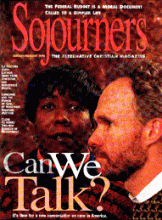All of us have lost somebody. Some have been shot. Some have been to prison. Some have been lost to drugs or alcohol. We're such beautiful people and we're killing ourselves. It's hard to talk about peace when we come with such pain, but I am inspired by you in the hope of nonviolence. This is the vision of my teacher, César Chávez: Si, Se Puede!
CALLED TO LET GO of their grief by Nane Alejandrez, the executive director of the gang-alternative organization Barrios Unidos, the young Latinos at last August's National Peace Summit gathered around a simple memorial to honor the names and symbols of their homeboys and homegirls lost to barrio warfare. Though no more than butcher paper taped to a wall in Santa Cruz's Civic Auditorium, the teen-agers brought it to life with their own hearts and souls, listing the names and symbols of those who had been killed in their neighborhoods.
The memorial became as sacred a reminder of the violence and pain of war for the young people at the Peace Summit as the black granite of the Vietnam Veterans Memorial in Washington, D.C. And though the scale differs greatly, to those caught up in the midst of the chaos that rules so many of our inner-city neighborhoods, the experience of warfare is no less real.
As the list overflows from one sheet of paper to two-and then to three-one can begin to sense the depth of the crisis in the Latino community. Nearly all of those listed on the memorial died young, killed as the violence of urban America caught up with them before they even had the chance to learn that the same streets they played in as children become urban free-fire zones when they reach adolescence.
Some families are disproportionately struck by the violence, such as that of Rudy Buchanan of Phoenix, who lost both of his sons in one year. Near the top of the list are the names of several of Nane's relatives, all lost to what he calls the "madness of the barrio."
Read the Full Article

